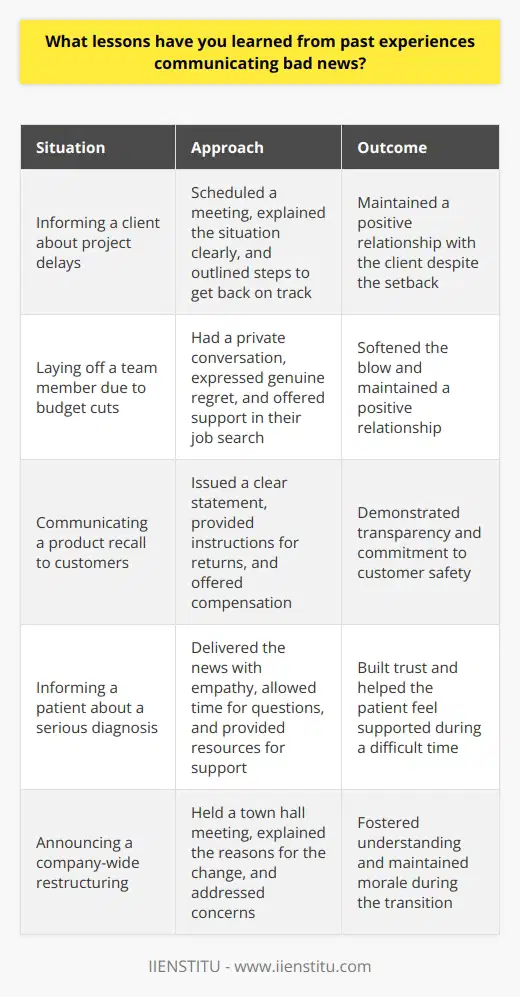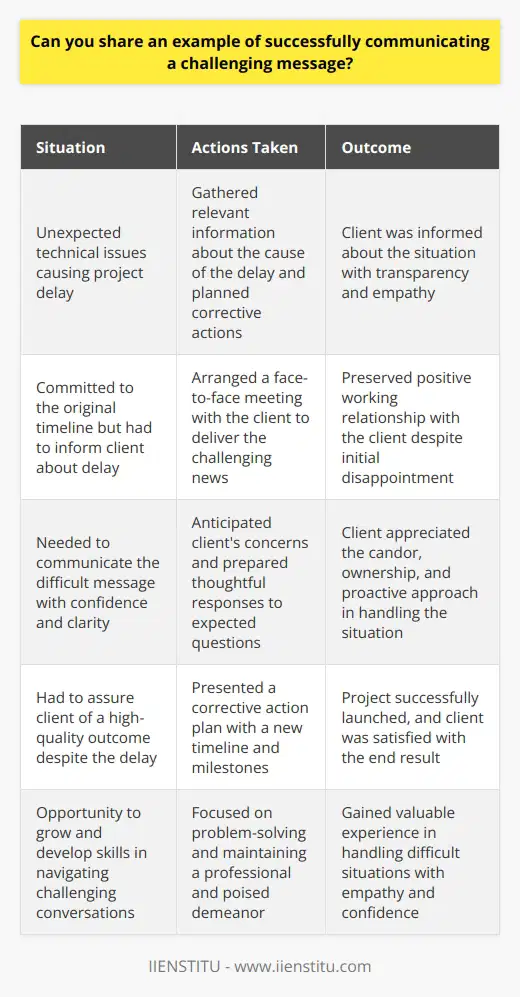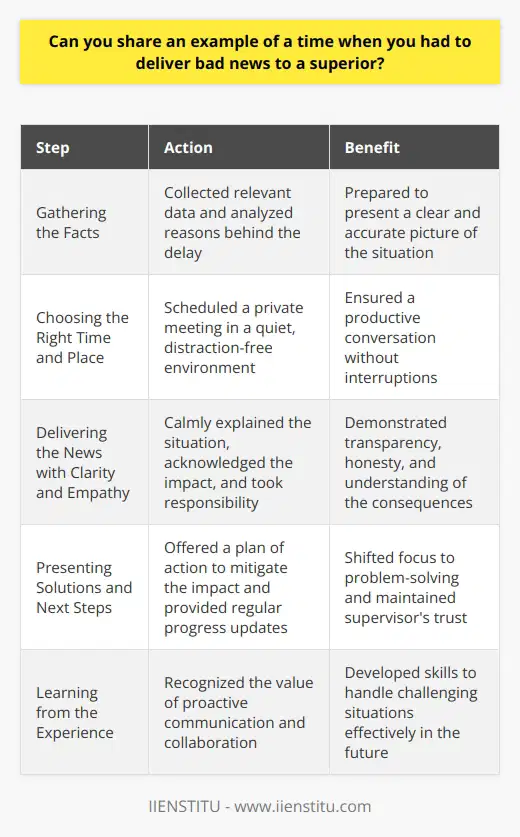
Getting to grips with how to communicate bad news in a corporate setting can be one of the most challenging aspects of professional life. I still remember the first time I had to deliver unfavorable news to a client. My palms were sweaty, my heart raced, and I rehearsed my words over and over again. Breaking bad news isn't just about what you say, but how you say it. It's an art that, when mastered, can preserve and even strengthen business relationships.
Navigating the Minefield of Delivering Bad News
In the world of business, not everything goes according to plan. There will be times when deadlines are missed, projects fall short, or unforeseen circumstances throw a wrench in even the best-laid strategies. Communicating bad news effectively is crucial because it can significantly impact how the message is received and how relationships are maintained thereafter.
Why Do Interviewers Ask About Communicating Bad News?
You might wonder, why is this topic so common in job interviews? Interviewers aren't just trying to put you on the spot; they're assessing your communication skills, emotional intelligence, and leadership potential. Being able to convey negative information with tact and empathy is a hallmark of a strong leader. It shows that you can handle difficult situations professionally and maintain composure under pressure.
Interview Question: How Do You Align Time Management with Long-Term Career Objectives?
Interview Question: How Does Time Management Play Into Your Networking or Social Engagements?
Interview Question: What Relaxes You During Stressful Times?
Interviewers are looking for candidates who can:
Demonstrate empathy: Understanding and acknowledging the recipient's feelings.
Maintain professionalism: Keeping the conversation respectful and appropriate.
Provide solutions: Offering a way forward despite the setback.
Communicate clearly: Ensuring the message is understood without ambiguity.
My Personal Experience with Delivering Bad News
In one of my previous roles as a project manager, we were working on a critical project for a major client. Due to unforeseen supply chain issues, we realized we wouldn't meet the agreed deadline. I had to inform the client about the delay—a conversation I wasn't looking forward to.
I scheduled a meeting with the client, ensuring it was a time convenient for them. I began by expressing appreciation for their partnership and then explained the situation honestly. I took responsibility for the oversight and presented a revised plan, highlighting how we would optimize the supply chain management process to prevent future delays. To my relief, the client appreciated the transparency and our proactive approach to resolving the issue.
The Importance of Emotional Intelligence
Emotional intelligence plays a significant role when delivering bad news. It involves being aware of your own emotions and the emotions of others, and using that awareness to guide your communication.
Some tips to enhance emotional intelligence include:
1- Active Listening: Pay attention to the recipient's reactions and feedback.
2- Empathy: Put yourself in their shoes and acknowledge their feelings.
3- Self-Regulation: Stay calm and composed, even if the conversation becomes tense.
4- Motivation: Focus on finding a positive outcome or solution.
Strategies for Communicating Bad News Effectively
Delivering bad news doesn't have to be a dreaded task. With the right approach, it can be an opportunity to build trust and demonstrate integrity. Here are some strategies that I've found helpful:
1. Prepare in Advance
Before initiating the conversation, gather all the relevant information. Understand the reasons behind the bad news and anticipate possible questions.
2. Choose the Right Time and Place
Ensure you have the conversation privately and at a suitable time. Avoid delivering bad news in public or during high-stress periods.
3. Be Direct and Honest
Clarity is key. Be straightforward about the issue without unnecessary jargon or beating around the bush.
4. Show Empathy
Acknowledge the impact of the news on the recipient. Phrases like "I understand how this may affect your plans..." can help convey empathy.
5. Offer Solutions or Alternatives
Whenever possible, provide options to mitigate the situation. This demonstrates proactivity and a commitment to resolving the issue.
How can you effectively convey unfortunate news?
What strategies can you use to deliver bad news?
What approach would you take to share upsetting information?
Can you provide an example of a situation where you had to communicate disappointing news?
If you had to inform someone about some negative news, how would you go about it?
What do you think is the best method to relay bad news?
What considerations should be kept in mind while communicating unfortunate updates?
How would you handle the task of giving someone bad news?
In your opinion, what is the most compassionate way of delivering sorrowful news?
Are there any specific techniques to make conveying bad news less daunting?
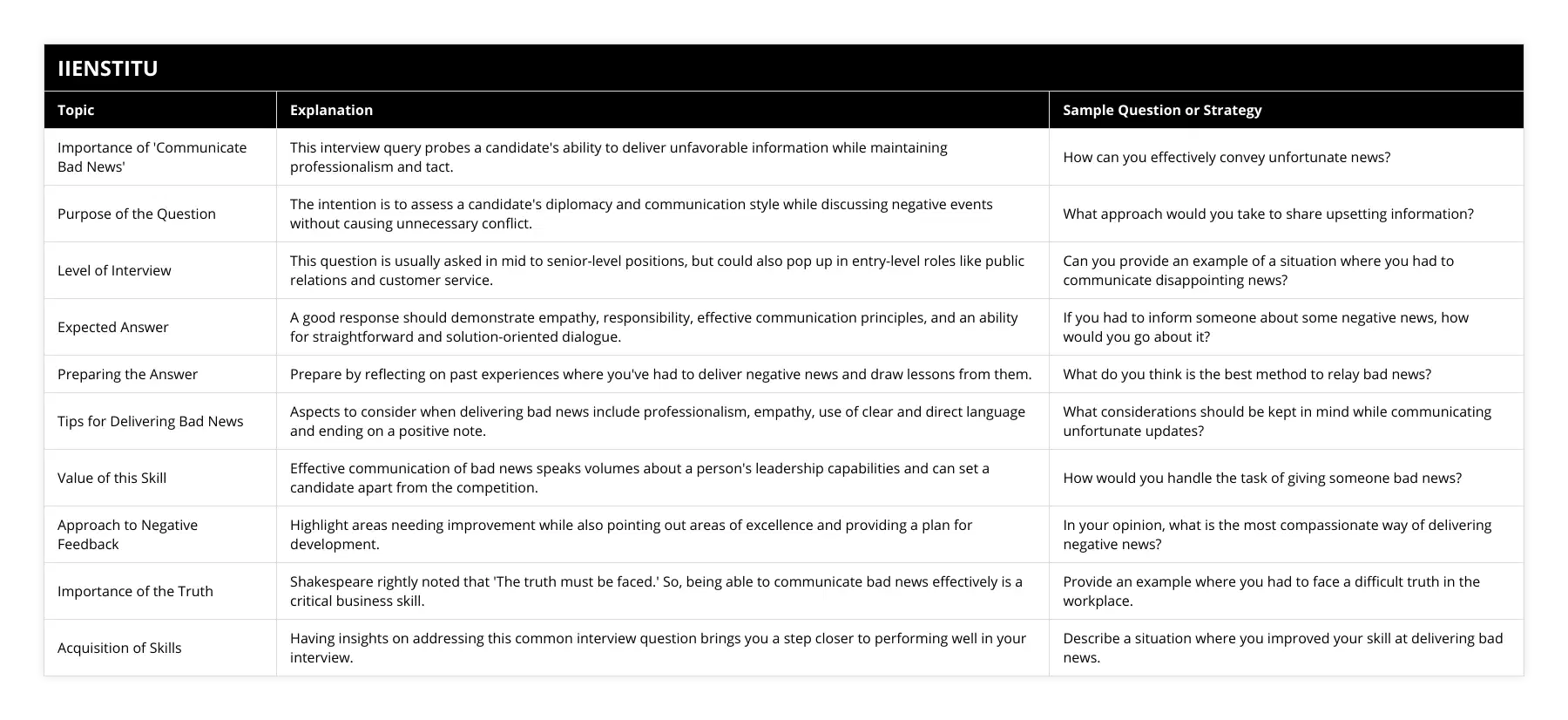
"In the midst of every crisis, lies great opportunity."
— Albert Einstein
Common Mistakes to Avoid
While it's important to know what to do, it's equally crucial to recognize common pitfalls:
Avoiding the Conversation: Delaying only makes things worse.
Being Vague: This can lead to misunderstandings and mistrust.
Overloading with Information: Stick to the essential facts to prevent overwhelming the recipient.
Blaming Others: Taking responsibility shows maturity and integrity.
The Role of Effective Communication in Leadership
Strong communication skills are at the heart of effective leadership. Leaders are often the bearers of both good and bad news. How they handle these situations can influence team morale and the overall organizational culture.
Benefits of Effective Communication:
Builds Trust: Transparency fosters trust among team members and stakeholders.
Enhances Team Cohesion: Clear communication can unify a team, even during tough times.
Facilitates Problem-Solving: Open dialogues encourage collaborative solutions.
Applying These Skills in Interviews
When faced with the interview question, "How do you communicate bad news?", it's an opportunity to showcase your skills. Here's how you might structure your answer:
1- Set the Scene: Briefly describe the context of the situation.
2- Explain Your Approach: Detail the steps you took to prepare and deliver the news.
3- Highlight the Outcome: Share the results of your approach and any lessons learned.
4- Reflect on the Experience: Discuss how this experience has shaped your communication style.
Sample Answer:
"In my last role, our team faced a significant budget cut that would affect project timelines. I knew I had to inform my team promptly. I scheduled a meeting where I explained the situation transparently, acknowledged their potential concerns, and together we brainstormed ways to adapt our processes. This collaborative approach not only helped us adjust but also strengthened our team's resilience."
Integrating SEO Keywords Naturally
In today's digital age, optimizing communication isn't limited to interpersonal interactions. It extends to how we present information online. For instance, companies often need to optimize supply chain management process tips to improve efficiency and transparency. Sharing such valuable insights can position a business as a thought leader in their industry.
Tips and Techniques for Delivering Bad News to Clients
Communicating bad news to clients requires additional tact. Here are some techniques that can help:
Personalize the Message: Tailor your communication to the client's preferences and personality.
Maintain Professionalism: Keep the tone respectful and avoid emotional language.
Provide Context: Help the client understand the reasons behind the news.
Follow Up: Check in after the initial conversation to address any lingering concerns.
Example Table: Steps for Delivering Bad News
| Step | Description |
|-------------------------------|-----------------------------------------------------|
| Preparation | Gather facts and anticipate questions |
| Setting | Choose an appropriate time and place |
| Delivery | Be clear, concise, and compassionate |
| Solution Offerings | Present possible solutions or alternatives |
| Follow-Up | Provide additional support and resources |
The Silver Lining of Bad News
It's important to remember that bad news isn't always the end of the story. How we handle these moments can lead to growth and innovation. For example, a project setback might inspire a more efficient workflow or uncover hidden inefficiencies.
Conclusion
In conclusion, communicating bad news is an inevitable part of professional life, but it doesn't have to be a negative experience. By approaching these conversations with empathy, honesty, and a solution-oriented mindset, we can navigate them effectively and maintain strong relationships.
Remember, the key is not just in delivering the message, but in how we connect with the other person during the process. As Maya Angelou wisely said, "People will forget what you said, people will forget what you did, but people will never forget how you made them feel."
References
Goleman, D. (1995). Emotional Intelligence. Bantam Books.
Covey, S. R. (1989). The 7 Habits of Highly Effective People. Free Press.
Harvard Business Review. (2010). On Communication. Harvard Business School Publishing.
Patterson, K., Grenny, J., McMillan, R., & Switzler, A. (2012). Crucial Conversations: Tools for Talking When Stakes Are High. McGraw-Hill.
Carnegie, D. (1936). How to Win Friends and Influence People. Simon & Schuster.
Similar Interview Questions to Consider
How can you effectively convey unfortunate news?
What strategies can you use to deliver bad news?
What approach would you take to share upsetting information?
Can you provide an example of a situation where you had to communicate disappointing news?
If you had to inform someone about some negative news, how would you go about it?
What do you think is the best method to relay bad news?
What considerations should be kept in mind while communicating unfortunate updates?
How would you handle the task of giving someone bad news?
In your opinion, what is the most compassionate way of delivering sorrowful news?
Are there any specific techniques to make conveying bad news less daunting?
Remember, mastering the art of delivering bad news isn't just about mitigating the immediate impact—it's about building a foundation of trust and openness that can enhance all your professional relationships. So next time you're faced with this challenge, embrace it as an opportunity to demonstrate your leadership and communication prowess.
Frequently Asked Questions
How do you approach delivering unfavorable news to a client or colleague?
When delivering unfavorable news, I believe in being direct, honest, and empathetic. I try to put myself in the other person's shoes and understand how the news may affect them.
Be Prepared
Before the conversation, I gather all the relevant facts and think through potential questions or concerns. I also consider the best time and place to have the discussion.
Deliver the News Clearly
I aim to communicate the information clearly and concisely, without sugarcoating or being overly blunt. I explain the reasons behind the decision and take responsibility where appropriate.
Listen and Acknowledge
After sharing the news, I give the other person a chance to process and respond. I listen actively to their concerns and acknowledge their feelings, even if I can't change the outcome.
Offer Support
Depending on the situation, I try to offer resources or solutions to help them move forward. I also follow up to ensure they have the support they need.
In my experience, approaching difficult conversations with transparency, compassion, and a problem-solving mindset can help maintain trust and relationships, even in challenging circumstances.
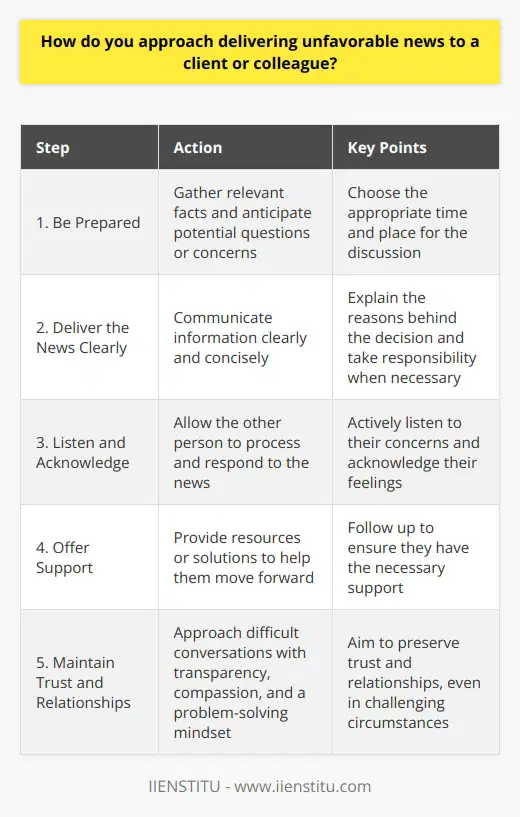
What strategies do you use to maintain a positive relationship when communicating bad news?
When delivering bad news, I prioritize open and honest communication. I believe it's essential to be direct and transparent, while also showing empathy and understanding for the person receiving the news.
Preparing for the Conversation
Before the discussion, I gather all relevant facts and consider potential questions or concerns the other person may have. This allows me to provide clear, concise answers and demonstrates that I've thoughtfully considered their perspective.
Choosing the Right Setting
Whenever possible, I have these conversations in person or over video chat. Face-to-face communication allows for better rapport and nonverbal cues, which can help maintain a positive relationship even during difficult discussions.
Delivering the News with Empathy
During the conversation, I use a calm and professional tone while also expressing genuine care and concern. I acknowledge their feelings and listen actively to their responses, giving them space to process the information and ask questions.
Focusing on Solutions
After delivering the news, I shift the focus towards potential solutions or next steps. I offer my support and resources to help them navigate the situation, showing that I'm invested in working through this together.
Following Up
I always follow up after the initial conversation to check in on how they're doing. This simple act reinforces that I value our relationship and am here to support them beyond just delivering the news.
By approaching difficult conversations with empathy, transparency, and a solutions-oriented mindset, I strive to maintain positive relationships even in challenging circumstances.

How do you ensure that the message is clear and understood when conveying bad news?
When conveying bad news, I always strive to be direct, honest, and empathetic. I believe that clarity is key, so I make sure to explain the situation in simple terms without sugarcoating or beating around the bush.
Choosing the Right Words
I carefully choose my words to ensure that the message is not misinterpreted. I avoid using jargon or technical terms that might confuse the listener. Instead, I opt for plain language that gets the point across effectively.
Providing Context
To help the recipient understand the gravity of the situation, I provide relevant context and background information. This allows them to see the bigger picture and grasp the implications of the bad news.
Showing Empathy
I always put myself in the other person's shoes and acknowledge their feelings. I use phrases like "I understand that this is difficult" or "I know this isn't what you were hoping for" to show that I empathize with their situation.
Offering Support
After delivering the bad news, I make sure to offer my support and assistance. I let them know that I'm available to answer any questions or provide further clarification if needed.
Following Up
Finally, I follow up with the recipient to ensure that they fully understood the message. I give them a chance to ask questions and express their concerns. This helps to minimize misunderstandings and ensures that everyone is on the same page.

Can you describe a time when you had to communicate a difficult message?
In my previous role as a project manager, I had to inform a client about a significant delay in their project timeline. This was due to unforeseen technical issues that our team encountered during the development phase.
Preparing for the Conversation
I knew this news would be disappointing for the client, so I carefully prepared my message in advance. I gathered all the relevant information, including the reasons for the delay and our proposed solutions to get the project back on track.
Delivering the Message
During the meeting, I was honest and transparent about the situation. I explained the technical challenges we faced and took responsibility for the delay on behalf of my team. I also emphasized our commitment to finding a resolution and presented a revised timeline for completing the project.
Listening and Addressing Concerns
I actively listened to the client's concerns and responded empathetically. I acknowledged their frustration and assured them that we were doing everything possible to minimize the impact of the delay. I also offered regular progress updates to keep them informed and maintain their trust.
Finding a Solution
After the meeting, I worked closely with my team to implement the proposed solutions and expedite the project. We put in extra hours and resources to get things back on track. In the end, we managed to deliver the project only a week behind the original schedule, and the client appreciated our efforts and transparency throughout the process.
This experience taught me the importance of proactive communication, honesty, and problem-solving when facing difficult conversations with clients or stakeholders.
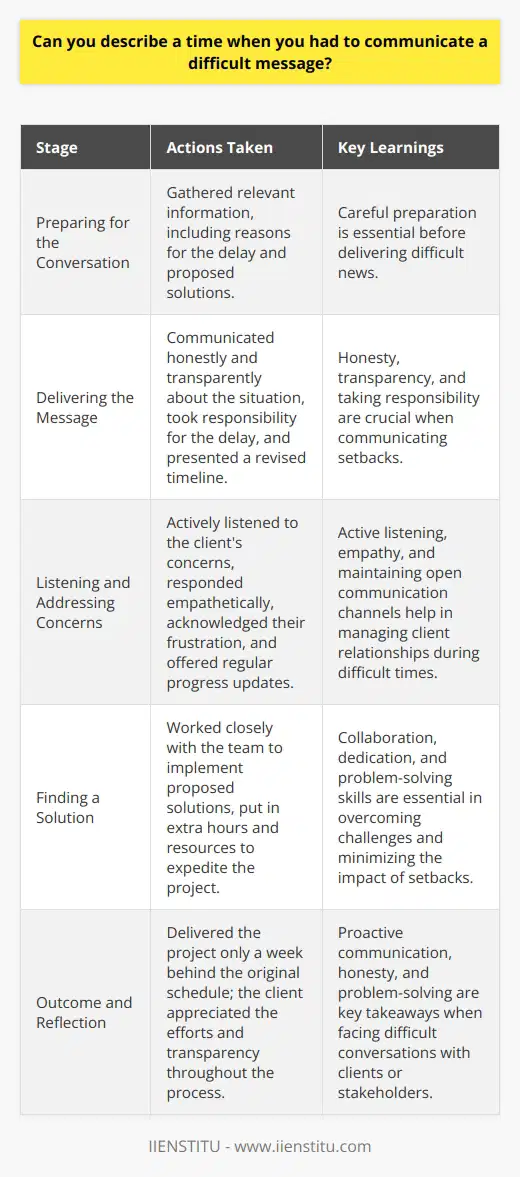
What steps do you take to prepare yourself before delivering bad news?
When delivering bad news, I first gather all the relevant facts and information to ensure I have a complete understanding of the situation. This allows me to anticipate potential questions and concerns the recipient may have.
Preparing the Message
I carefully consider how to frame the message in a clear, concise, and compassionate manner. I aim to be direct while still showing empathy for the impact the news may have on the person receiving it.
Choosing the Right Time and Place
Whenever possible, I try to deliver bad news in person and in a private setting. This allows for a more personal conversation and gives the recipient a safe space to process their emotions.
Practicing Active Listening
During the conversation, I make a point to practice active listening. I give the person my full attention and allow them to express their thoughts and feelings without judgment or interruption.
Following Up
After delivering the news, I follow up with the person to see how they're doing and offer any additional support or resources they may need. I believe it's important to show that you care about their well-being beyond just the initial conversation.
In my experience, taking these steps helps to create a more compassionate and supportive environment when delivering difficult news. It's never easy, but approaching the situation with empathy and preparation can make a significant difference in how the message is received.
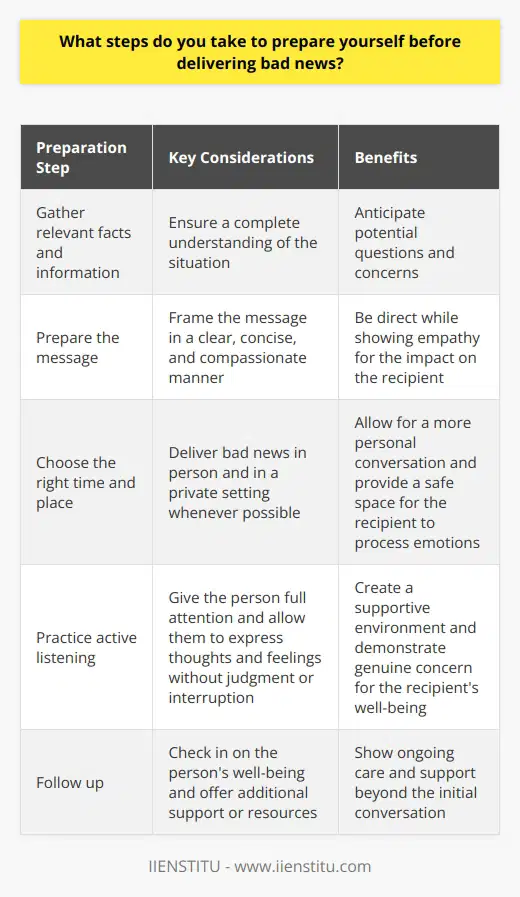
How do you handle the emotional response of the recipient when communicating bad news?
When communicating bad news, I first acknowledge the recipient's feelings and show empathy for their situation. I believe it's crucial to create a safe space where they feel heard and understood. This helps build trust and makes the conversation more productive.
Delivering the News
I strive to be direct and honest when delivering bad news. Beating around the bush only prolongs the discomfort. At the same time, I'm sensitive in my word choices. I explain the situation objectively, focusing on facts rather than opinions or blame.
Offering Support
After sharing the news, I give the person time to process their emotions. I offer my support and listen attentively if they want to talk. Sometimes, simply being present and validating their feelings can be incredibly helpful.
Finding Solutions
Once the initial shock has passed, I gently guide the discussion towards problem-solving. I ask the recipient for their ideas and input. Collaborating on solutions helps them feel more in control. Together, we break down next steps into manageable actions.
Following Up
I always follow up after a difficult conversation. I check in to see how the person is doing and reiterate my support. This shows that I genuinely care about their wellbeing beyond just delivering the news.
Communicating bad news is never easy, but with empathy, honesty, and a solution-focused approach, it can be handled with grace. I aim to be a steady source of support throughout the process.
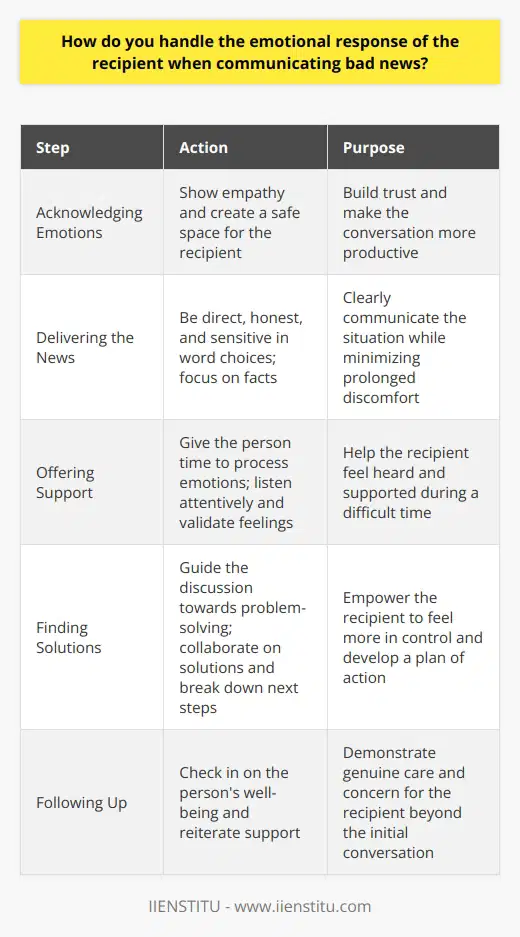
What follow-up actions do you take after delivering an unfavorable message?
When delivering an unfavorable message, I take several follow-up actions to ensure clarity and maintain professional relationships.
Clarify the Reasons
I always strive to clearly explain the reasons behind the unfavorable decision. This helps the recipient understand the context and reduces confusion or misinterpretation. For example, when informing a candidate they didn't get the job, I might say, "While your qualifications were impressive, we found another applicant whose skills more closely aligned with our current needs."
Offer Alternatives or Suggestions
Whenever possible, I try to provide alternatives or suggestions to soften the blow of the unfavorable message. This shows empathy and a willingness to help. In the case of a job rejection, I might suggest other open positions they could apply for or resources for improving their skills.
Keep the Door Open
I believe in maintaining positive relationships, even when delivering bad news. I express appreciation for their time and effort, and encourage them to keep in touch. I might say something like, "We value your interest in our company. Please feel free to apply for future openings that match your qualifications."
Follow Up Personally
In some cases, I follow up with a personal phone call or email to ensure the message was received and understood. This allows me to address any questions or concerns they may have and demonstrates a genuine interest in their well-being.
By taking these follow-up actions, I aim to handle unfavorable situations with professionalism, empathy, and respect for all involved.

How do you balance empathy and professionalism when communicating bad news?
Balancing empathy and professionalism when delivering bad news is a delicate but essential skill. I once had to inform a client that their project was delayed due to unforeseen circumstances. It was a challenging conversation, but I knew I had to handle it with care and sensitivity.
Acknowledge the Difficulty of the Situation
First, I always acknowledge that the news I'm delivering is difficult to hear. This shows that I understand the impact it may have on the person and their feelings. A simple phrase like, "I understand this may be disappointing to hear" can go a long way in demonstrating empathy.
Be Clear and Direct
While it's important to be sensitive, it's equally crucial to be clear and direct about the news. Avoiding the truth or sugarcoating it can lead to confusion and mistrust. I make sure to explain the situation clearly and concisely, providing the necessary details without overwhelming them.
Offer Support and Solutions
After delivering the news, I focus on offering support and potential solutions. I ask questions to understand their concerns and see how I can help. If there are steps we can take to mitigate the impact, I propose them. This shows that I'm committed to working through the challenge together.
Follow Up and Keep Communication Open
Finally, I ensure to follow up after the conversation and keep the lines of communication open. I let them know that I'm available if they have further questions or need assistance. By maintaining open and empathetic communication, I aim to build trust and strengthen the professional relationship, even in difficult times.
Balancing empathy and professionalism when delivering bad news is a skill that requires practice and emotional intelligence. By acknowledging the challenge, being clear and direct, offering support, and keeping communication open, we can navigate these situations with grace and professionalism while still being human.
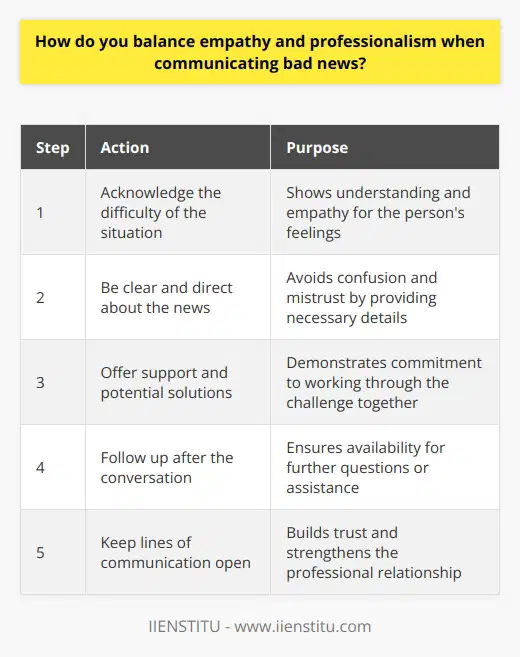
What communication channels do you prefer when delivering bad news and why?
When delivering bad news, I prefer face-to-face communication whenever possible. This allows me to convey empathy and understanding through my tone and body language, which can help soften the blow of the message.
Benefits of Face-to-Face Communication
In-person conversations provide opportunities for immediate feedback and dialogue. I can address concerns, answer questions, and ensure the message is clearly understood. It also shows respect for the recipient, demonstrating that I value them enough to deliver the news personally.
Alternative Channels for Remote Teams
When face-to-face isn't an option, I opt for video calls. Seeing each other's faces maintains a human connection. For less sensitive matters, I may choose a phone call followed by a detailed email summarizing the conversation.
Adapting to Individual Preferences
I recognize that people have different communication preferences. Some may prefer to process information privately first. In these cases, I send a carefully worded email, offering to discuss further if needed. I tailor my approach to the individual and situation.
Thoughtful Delivery Is Key
Ultimately, when sharing difficult news, I prioritize clear, compassionate communication through the most appropriate channel. My goal is to deliver the message respectfully while minimizing additional stress for the recipient. With care and tact, even challenging conversations can be handled professionally.
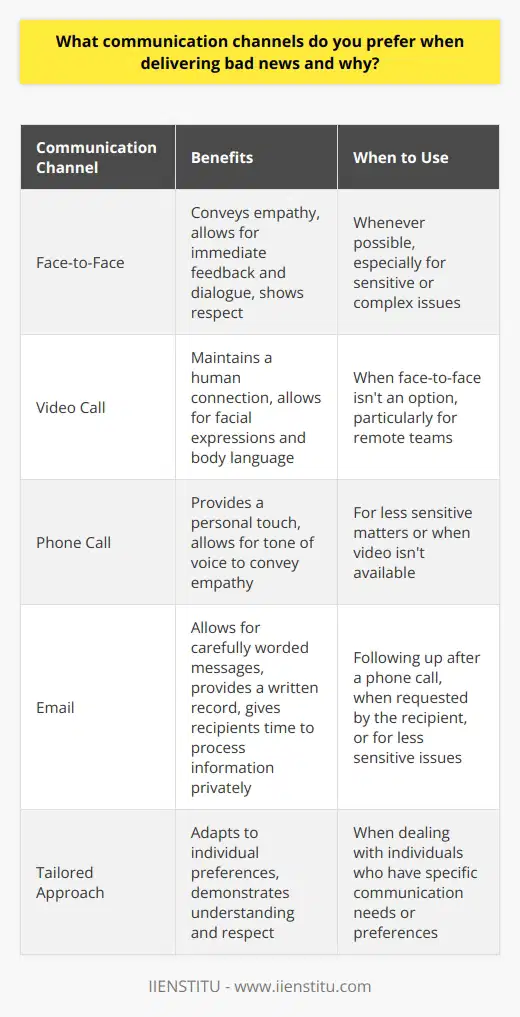
How do you adapt your communication style when conveying bad news to different audiences?
When conveying bad news, I always consider my audience and tailor my communication style accordingly. For example, when communicating with a client, I maintain a professional and empathetic tone, clearly explaining the situation and offering solutions or next steps. I use simple, straightforward language to ensure the message is easily understood.
Adapting to Internal Audiences
When delivering bad news to my team or colleagues, I try to be more personal and supportive. I acknowledge their feelings and concerns, and I emphasize that we're in this together. I also provide a clear action plan and encourage open communication to address any questions or issues that may arise.
Communicating with Senior Management
When communicating bad news to senior management, I focus on being concise and data-driven. I present the facts, potential impact, and recommended solutions. I also demonstrate that I've thoroughly analyzed the situation and am prepared to answer any questions they may have.
The Importance of Active Listening
Regardless of the audience, I always practice active listening. I pay attention to their reactions, both verbal and nonverbal, and adjust my communication style as needed. If I sense confusion or concern, I pause to clarify or address their worries.
Continuous Improvement
Adapting my communication style when delivering bad news is an ongoing learning process. I seek feedback from my audience and reflect on what worked well and what I could improve. This helps me continue to refine my approach and become a more effective communicator.

What do you consider the most important aspects of effectively communicating bad news?
When delivering bad news, I believe empathy and clarity are paramount. It's crucial to put yourself in the recipient's shoes and consider how they might feel receiving the information.
Be Direct and Honest
While it's tempting to sugarcoat things, it's best to be upfront. Dancing around the issue only prolongs the discomfort. State the core message clearly and concisely, without excessive detail that could overwhelm.
Show Compassion and Understanding
Acknowledge that the news may be difficult to hear. Validate their feelings, whether it's disappointment, frustration, or sadness. Emphasize that you understand where they're coming from. A little empathy goes a long way.
Offer Support and Solutions
After delivering the news, shift the focus to how you can help. Discuss potential solutions, resources, or next steps. Make it a collaborative conversation. Empower them to move forward constructively.
Allow Space for Processing
Bad news can be shocking. Give the person time to absorb and react. Avoid pressuring them for an immediate response. Let them know you're available to talk more whenever they're ready.
In my experience, whenever I've had to share difficult updates, approaching the conversation with compassion and honesty helped immensely. It's never easy, but communicating with clarity, empathy, and openness to dialogue can make all the difference.
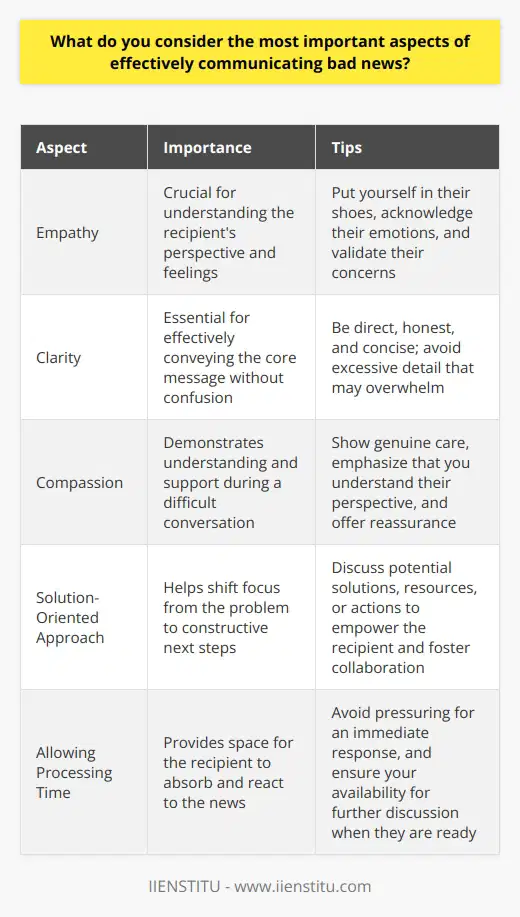
How do you ensure that the gravity of the situation is conveyed without causing undue alarm?
When conveying the gravity of a situation, it's crucial to strike a balance between clarity and sensitivity. I've found that the key is to communicate the facts in a calm, measured tone. This helps prevent panic while ensuring that the message is understood.
Focus on the Facts
I always aim to present the reality of the situation without exaggeration or understatement. Sticking to the facts allows people to grasp the seriousness without becoming overwhelmed by emotions. It's about providing a clear, honest assessment that enables informed decision-making.
Choose Your Words Carefully
The language you use can make all the difference. I try to avoid alarmist phrases that might provoke fear or anxiety. Instead, I opt for neutral, straightforward terms that convey the gravity without sensationalizing it. It's a delicate verbal dance, but with practice, it becomes more natural.
Offer Reassurance and Solutions
While it's important to be truthful about the challenges at hand, I believe it's equally vital to provide hope and guidance. Whenever possible, I pair the gravity of the situation with potential solutions or steps forward. This helps alleviate some of the stress and shows that there are ways to navigate even the toughest circumstances.
Lead by Example
In my experience, people take cues from those around them, especially in high-pressure moments. If I can maintain a calm, focused demeanor, it often has a ripple effect. By embodying the balance between seriousness and steadiness, I've found that I can inspire others to approach the situation with a similar mindset.
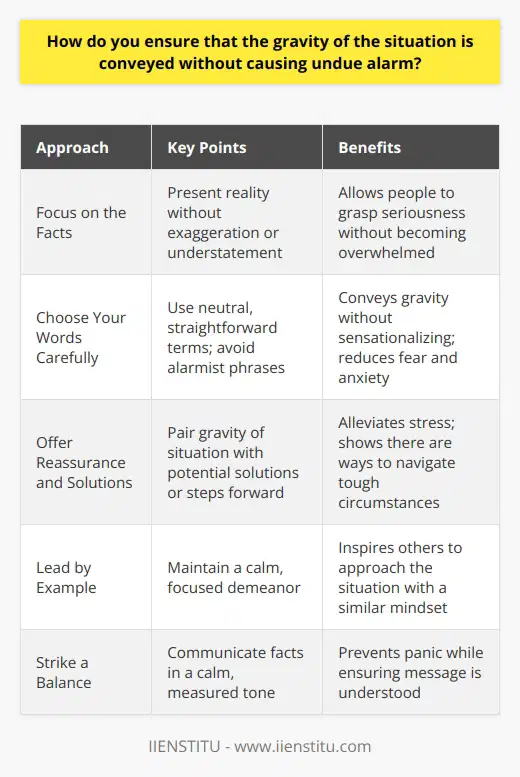
Can you discuss a time when communicating bad news led to a positive outcome?
In my previous role as a marketing manager, I had to inform a client that their campaign was not performing as expected. This was a challenging conversation, but I approached it with honesty and empathy.
Preparing for the Discussion
Before the meeting, I gathered all the relevant data and insights to support my findings. I also brainstormed potential solutions and alternative strategies to present to the client.
The Conversation
During the discussion, I acknowledged their disappointment and frustration. However, I also highlighted the valuable lessons we had learned from the campaign's performance. Together, we identified areas for improvement and explored new creative ideas.
Positive Outcome
As a result of this open and constructive dialogue, we strengthened our client relationship. They appreciated my transparency and proactive approach. We collaborated on a revised campaign strategy that ultimately exceeded their expectations and drove significant business growth.
Key Takeaways
This experience taught me the importance of facing challenges head-on with clarity and compassion. By focusing on solutions rather than dwelling on setbacks, we can turn difficult conversations into opportunities for growth and success.
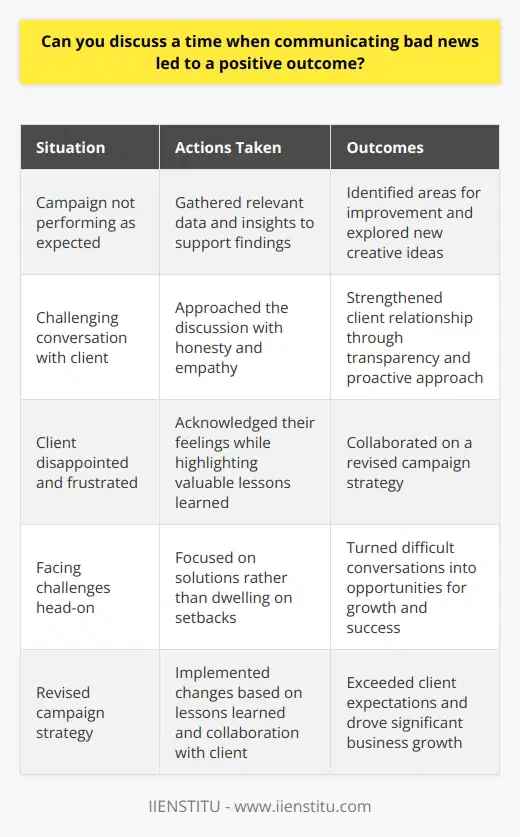
What techniques do you use to maintain composure when delivering unfavorable news?
When delivering unfavorable news, I focus on being direct, honest, and empathetic. I believe in treating others with respect and understanding, even when the message is difficult.
Preparing for the Conversation
Before the conversation, I gather all the relevant facts and consider the recipient's perspective. I think about how they might react and what questions they may have. This mental preparation helps me stay calm and composed.
Delivering the News with Clarity and Compassion
During the discussion, I aim to be clear and concise. I explain the situation without sugarcoating or being unnecessarily blunt. I listen actively to their concerns and acknowledge their feelings. Showing genuine empathy helps maintain my own composure while supporting them through the process.
Following Up and Offering Support
After delivering the news, I make myself available for follow-up questions or further discussion. I offer resources or support if appropriate. By focusing on being helpful and solution-oriented, I can maintain my own emotional equilibrium while assisting others through challenging times.
In my experience, approaching difficult conversations with honesty, empathy, and a genuine desire to support others has helped me navigate many challenging situations while maintaining my own sense of calm and professionalism. It's not always easy, but with practice and a sincere commitment to open communication, it becomes more natural over time.
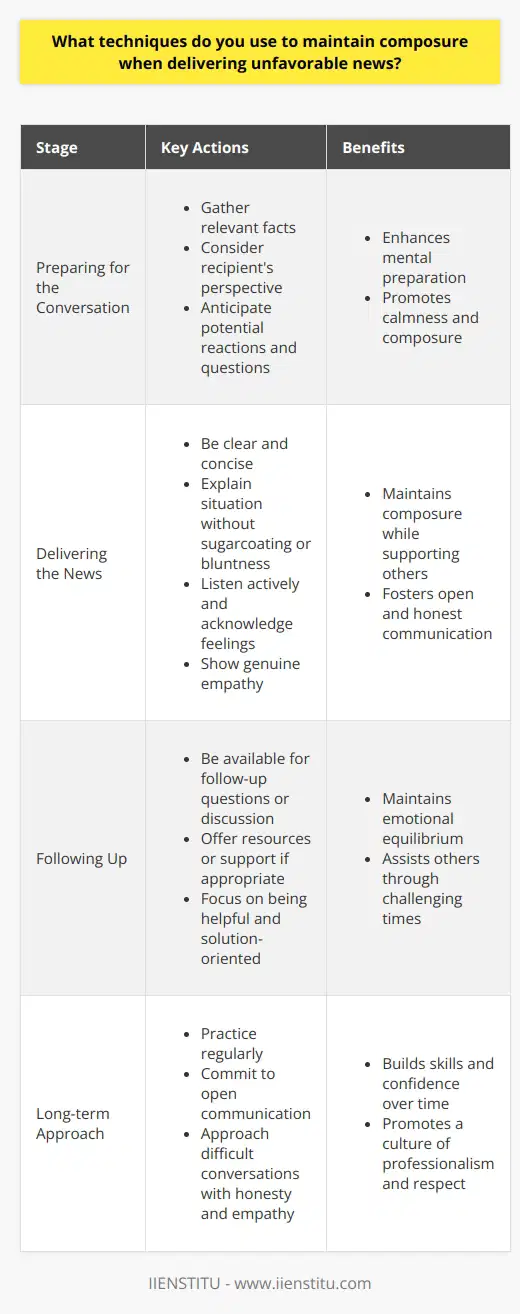
How do you demonstrate understanding and support when communicating bad news?
When communicating bad news, I focus on being direct, honest, and empathetic. I start by clearly stating the issue and then provide context to help the other person understand the situation.
Showing Empathy
I put myself in their shoes and acknowledge how they might be feeling. I'll say something like, "I know this isn't the outcome you were hoping for, and I understand this is disappointing."
Offering Support
Next, I emphasize that I'm there to support them however I can. Whether it's answering questions, providing resources, or exploring alternative solutions, I make it clear that we're in this together.
Being Solution-Oriented
While validating their emotions, I also try to pivot the conversation towards positive steps forward. I'll highlight any silver linings or opportunities that may come from this challenge.
Following Up
After delivering difficult news, I always make a point to check in again later. A quick call or email to see how they're doing shows that I truly care and am invested in helping them through the tough times.
At the end of the day, delivering bad news with compassion is both an art and a skill. It takes practice, but when you come from a place of genuine care and a commitment to support the other person, it makes all the difference.
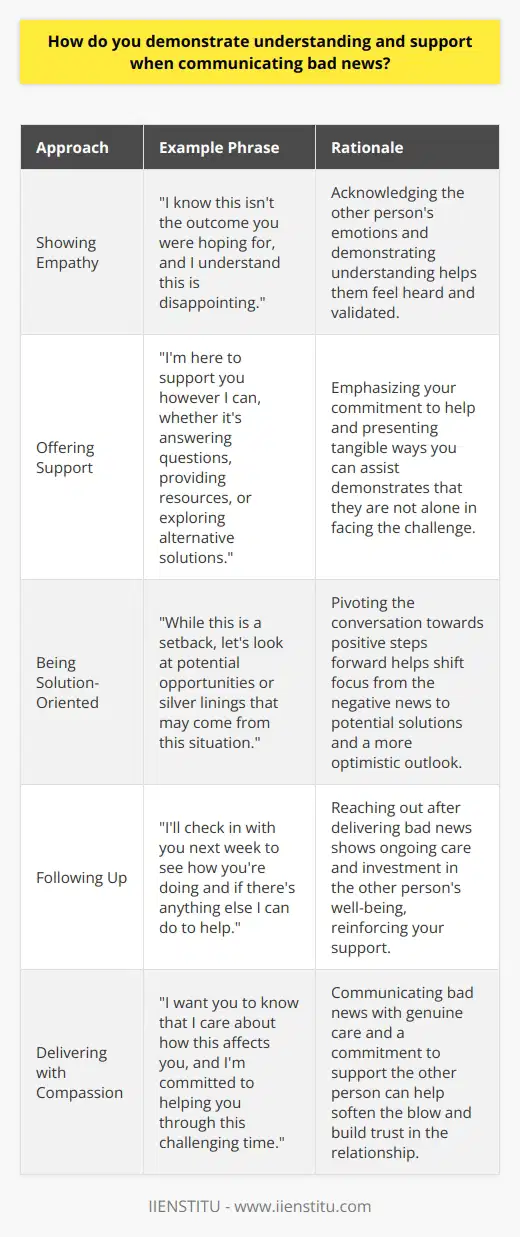
What are some common challenges you face when communicating bad news?
Communicating bad news is never easy, but it's a crucial skill in both personal and professional life. In my experience, the biggest challenge is finding the right balance between empathy and clarity. You want to deliver the message in a way that shows you understand the impact it may have, while also being direct and honest about the situation.
Timing and Setting Matter
Another challenge is choosing the appropriate time and place to have the conversation. I've learned that it's best to have these discussions in private, when both parties have enough time to process the information and ask questions. Rushing through or delivering bad news in a public setting can make an already difficult situation even worse.
Anticipate and Prepare for Reactions
It's also important to anticipate potential reactions and be prepared to address them. People may respond with anger, sadness, or confusion, and it's the communicator's job to remain calm and composed. I find it helpful to have additional information or resources available to offer support and guidance if needed.
Follow Up and Offer Support
Finally, I believe that communicating bad news doesn't end with the initial conversation. Following up to check in on the person, offering ongoing support, and being available to answer questions can go a long way in helping them navigate the situation. It shows that you care about their well-being beyond just delivering the message.
While it's never pleasant to be the bearer of bad news, approaching the task with empathy, clarity, and a supportive attitude can make a significant difference in how the message is received and processed.
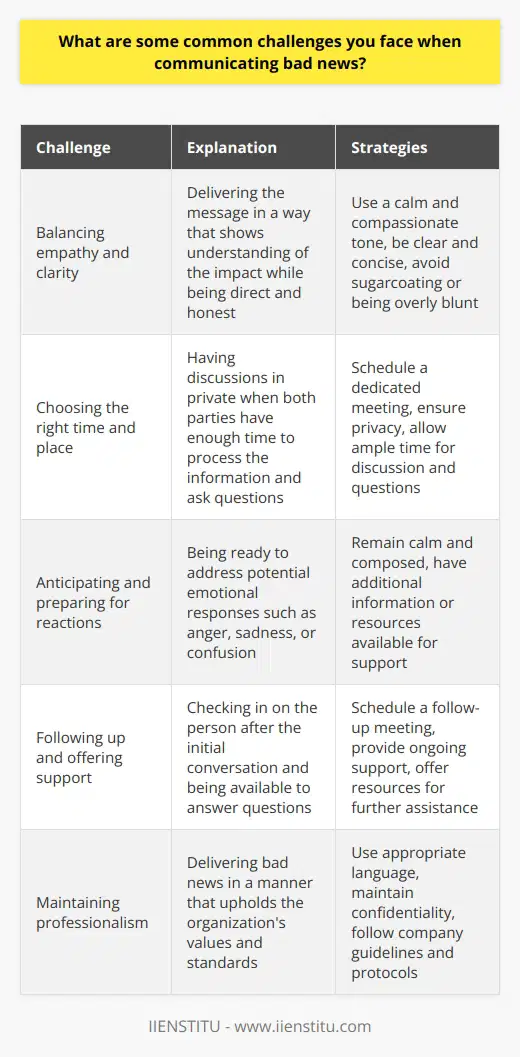
Can you describe a situation where you had to communicate bad news to a large group?
In my previous role as a project manager, I had to communicate a significant delay in a project to a large group of stakeholders. This included executives, team members, and clients who were eagerly anticipating the project's completion.
Preparing for the Communication
I knew that delivering this news would be challenging, so I carefully prepared my message. I gathered all the relevant information, including the reasons for the delay and the revised timeline. I also anticipated potential questions and concerns that might arise during the conversation.
Delivering the News
I scheduled a meeting with all the stakeholders and chose a time when everyone could attend. During the meeting, I began by acknowledging the importance of the project and the impact the delay would have on everyone involved. I then clearly explained the reasons behind the delay, taking responsibility for the situation as the project manager.
Addressing Concerns and Questions
After delivering the news, I opened the floor for questions and concerns. I actively listened to each person's input and addressed their concerns with empathy and understanding. I provided transparent and honest answers, even if they were difficult to hear.
Presenting a Plan Forward
To reassure the stakeholders, I presented a revised plan that outlined the steps we would take to get the project back on track. I highlighted the resources we would allocate and the measures we would implement to prevent further delays. I also set realistic expectations for the new timeline and deliverables.
Follow-up and Communication
After the meeting, I followed up with each stakeholder individually to ensure they felt heard and understood. I maintained open lines of communication throughout the project's remaining duration, providing regular updates on our progress and any potential challenges we encountered.
In the end, by communicating the bad news honestly, empathetically, and with a clear plan forward, I was able to maintain trust and confidence among the stakeholders, despite the setback.
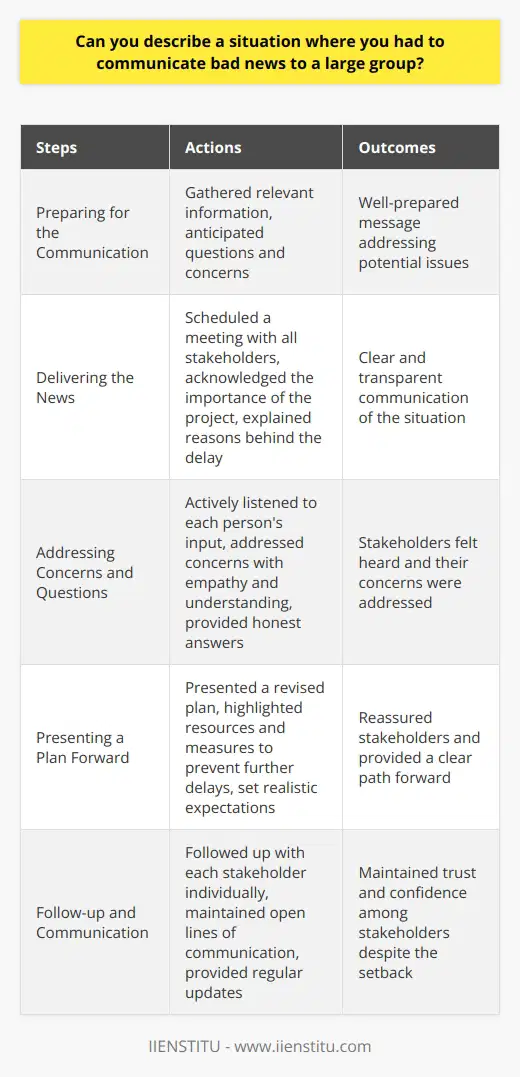
What strategies do you employ to encourage open dialogue after delivering bad news?
When delivering bad news, I believe in being direct and honest while also showing empathy and understanding. I start by clearly explaining the situation and the reasons behind the decision. This helps to establish trust and credibility with the team.
Encouraging Open Dialogue
After sharing the news, I make sure to create a safe space for open dialogue. I actively listen to any concerns or questions that team members may have. By validating their feelings and acknowledging the impact of the news, I show that I value their perspectives.
Focusing on Solutions
I try to shift the conversation towards finding solutions and moving forward. I ask for ideas and input from the team on how we can best address the challenges at hand. By involving them in the problem-solving process, I demonstrate that their opinions matter and that we're in this together.
Following Up
After the initial discussion, I make sure to follow up with individual team members. I check in to see how they're doing and if they have any further thoughts or concerns. This helps to maintain open lines of communication and shows that I'm committed to supporting them through the transition.
Leading by Example
Throughout the process, I strive to lead by example. I remain calm, composed, and focused on the future. By modeling resilience and a positive attitude, I hope to inspire the team to do the same. Together, we can navigate through the challenges and come out stronger on the other side.
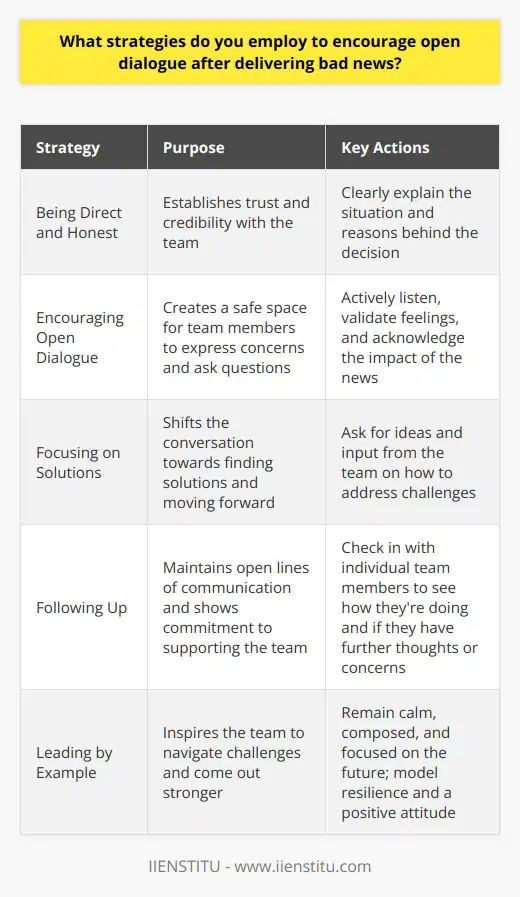
How do you handle a situation where the recipient becomes defensive or confrontational?
When facing a defensive or confrontational recipient, I first try to remain calm and composed. I listen actively to understand their perspective and concerns. By acknowledging their feelings, I aim to diffuse the tension and find common ground.
Techniques for Handling Confrontational Situations
Some strategies I've found effective include:
Learning from Past Experiences
I remember one particularly challenging client who was upset about a delayed project. By letting them air their frustrations fully before responding, I was able to identify how to get things back on track. We ended up strengthening our working relationship through that honest dialogue.
Importance of Empathy and Professionalism
Ultimately, I believe approaching tense conversations with empathy, respect, and a solutions-focused attitude is key. While it's not always easy, staying level-headed and professional helps me navigate even the thorniest confrontations and find positive resolutions. Each experience teaches me something new.
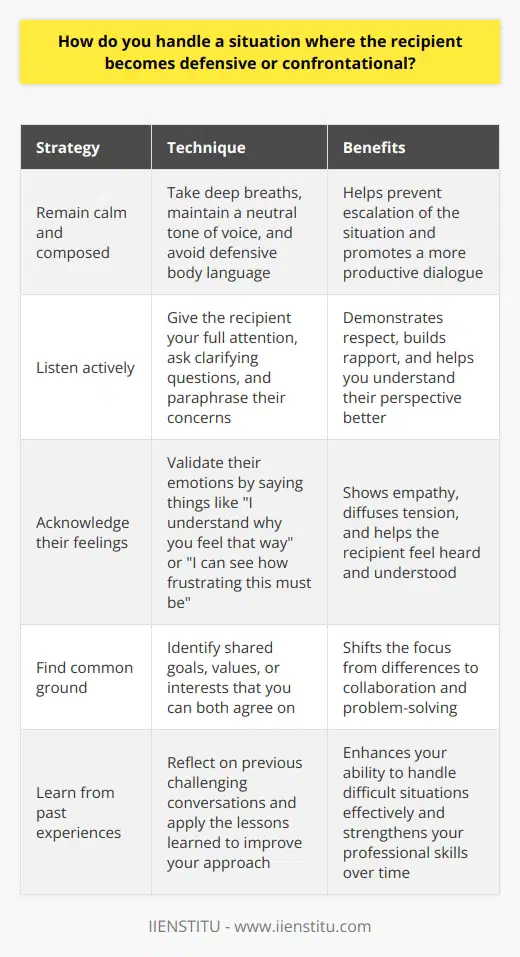
What are some best practices for communicating bad news in writing?
When communicating bad news in writing, it's essential to be clear, concise, and empathetic. I once had to inform a client that their project was delayed due to unforeseen circumstances. It was a challenging situation, but I learned some valuable best practices:
Be Direct and Honest
Don't beat around the bush. State the bad news clearly and upfront. Avoid using vague or ambiguous language that could lead to confusion or misinterpretation. In my case, I started the email by directly addressing the delay and apologizing for any inconvenience caused.
Provide Context and Explanations
Explain the reasons behind the bad news. Provide relevant details and context to help the recipient understand the situation better. When I informed my client about the project delay, I outlined the specific challenges we faced and the steps we were taking to mitigate them.
Show Empathy and Understanding
Acknowledge the impact of the bad news on the recipient. Show genuine empathy and understanding for their situation. In my email, I expressed my sincere apologies and assured the client that we were doing everything possible to minimize the impact of the delay on their business.
Offer Solutions or Next Steps
Don't just deliver the bad news; provide potential solutions or next steps. Offer alternatives, if possible, and outline a plan of action. When communicating the project delay, I proposed a revised timeline and assured the client that we would keep them updated on our progress.
Remember, the way you communicate bad news can significantly impact your professional relationships. By being direct, empathetic, and solution-oriented, you can navigate difficult conversations with grace and maintain trust with your colleagues and clients.
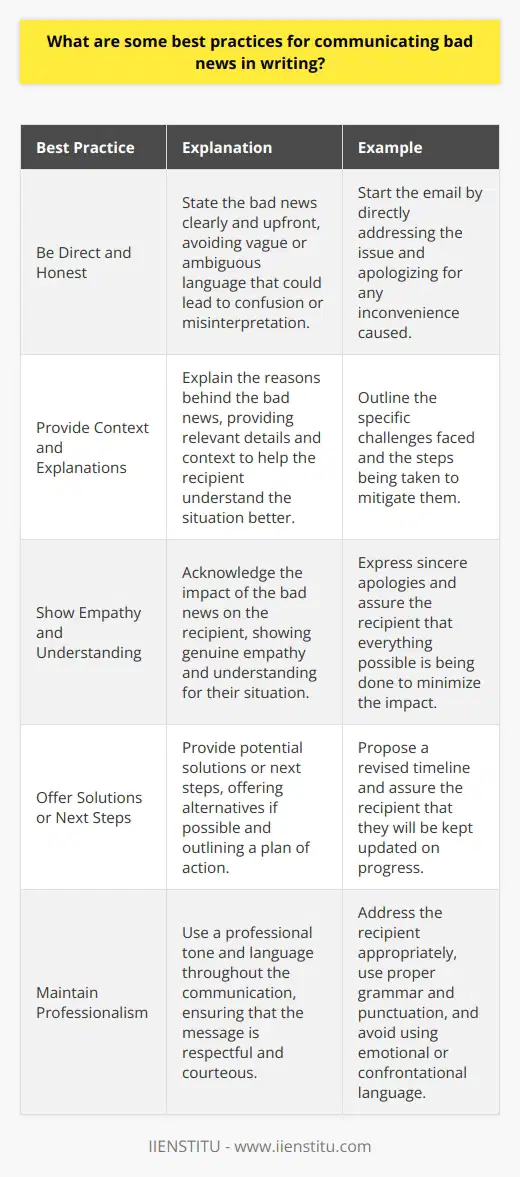
How do you ensure that the tone of your message is appropriate when conveying bad news?
When conveying bad news, I ensure the tone is appropriate by putting myself in the recipient's shoes. I consider how I would feel receiving the message and adjust my language accordingly. This helps me strike a balance between being direct and honest while also showing empathy and understanding.
Preparation is Key
Before delivering the news, I take time to gather all relevant information and plan my communication strategy. This allows me to anticipate potential questions or concerns and have thoughtful responses prepared. By being well-prepared, I can communicate more confidently and effectively.
Choose the Right Medium
Depending on the situation, I select the most appropriate communication channel. For sensitive or complex issues, I prefer face-to-face or phone conversations, as they allow for more personal interaction and immediate feedback. Written communication, such as email, can be useful for documenting the message or when a more formal tone is required.
Be Clear and Concise
When delivering bad news, I aim to be clear and concise. I avoid using jargon or beating around the bush. Instead, I state the facts plainly and directly, while still maintaining a respectful and compassionate tone. This helps prevent confusion and misinterpretation.
Offer Support and Solutions
After delivering the bad news, I focus on offering support and solutions. I acknowledge the challenges the recipient may face and express my willingness to help in any way I can. If possible, I provide alternative options or resources to help mitigate the impact of the news.
Follow Up
Finally, I always follow up after delivering bad news. I check in with the recipient to see how they are doing and if they have any further questions or concerns. This shows that I care about their well-being and am committed to supporting them through the situation.
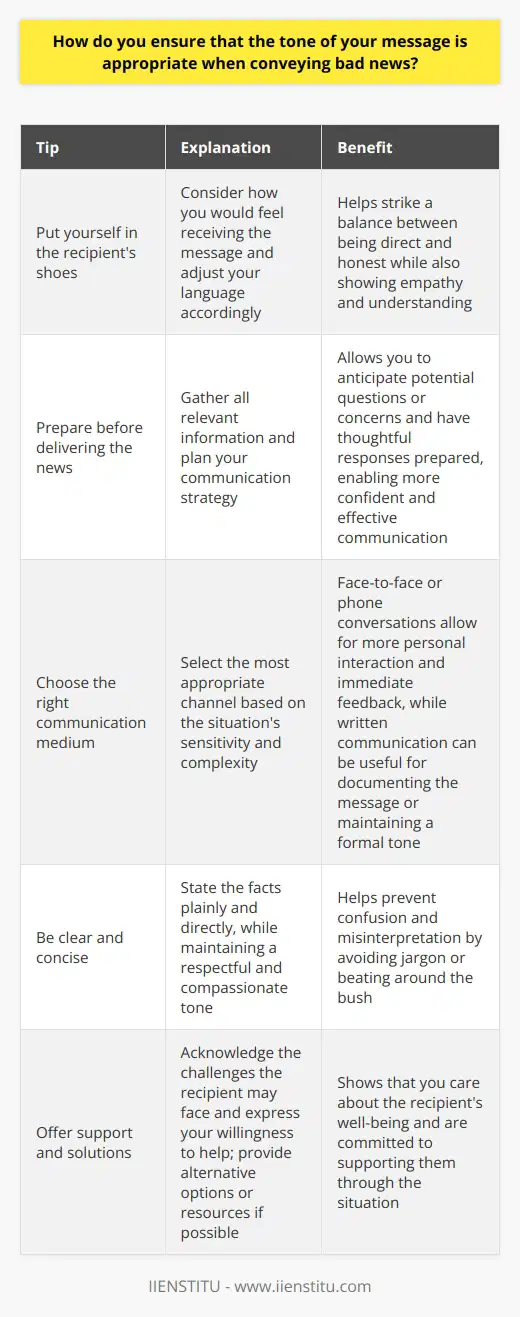
What techniques do you use to maintain trust and credibility when communicating unfavorable news?
When communicating unfavorable news, I prioritize transparency and empathy to maintain trust and credibility with my audience.
Be Direct and Honest
I believe in being straightforward and honest, even when the news is unpleasant. Sugarcoating or avoiding the truth can erode trust and make the situation worse in the long run. I once had to inform a client that their project was behind schedule due to unexpected challenges. Instead of making excuses, I took responsibility and explained the situation clearly, which helped us find a solution together.
Show Empathy and Understanding
When delivering bad news, I put myself in the other person's shoes and acknowledge their feelings. I listen actively to their concerns and respond with compassion. For example, when I had to announce layoffs at a previous company, I met with each affected employee individually, listened to their reactions, and offered support and resources to help them through the transition.
Focus on Solutions and Next Steps
After communicating the unfavorable news, I shift the focus to what can be done moving forward. I present potential solutions or action plans to address the situation. When a product launch was delayed, I immediately followed up with a revised timeline and specific steps we were taking to get back on track. This helped alleviate concerns and demonstrated our commitment to resolving the issue.
Follow Up and Keep Communication Open
I make sure to follow up after delivering bad news and keep the lines of communication open. I provide regular updates on progress and remain available to answer questions. After announcing a project cancellation, I scheduled weekly check-ins with the team to discuss their concerns and explore new opportunities. This helped maintain morale and kept everyone engaged.
By being direct, empathetic, solution-oriented, and committed to ongoing communication, I strive to maintain trust and credibility, even in challenging situations.
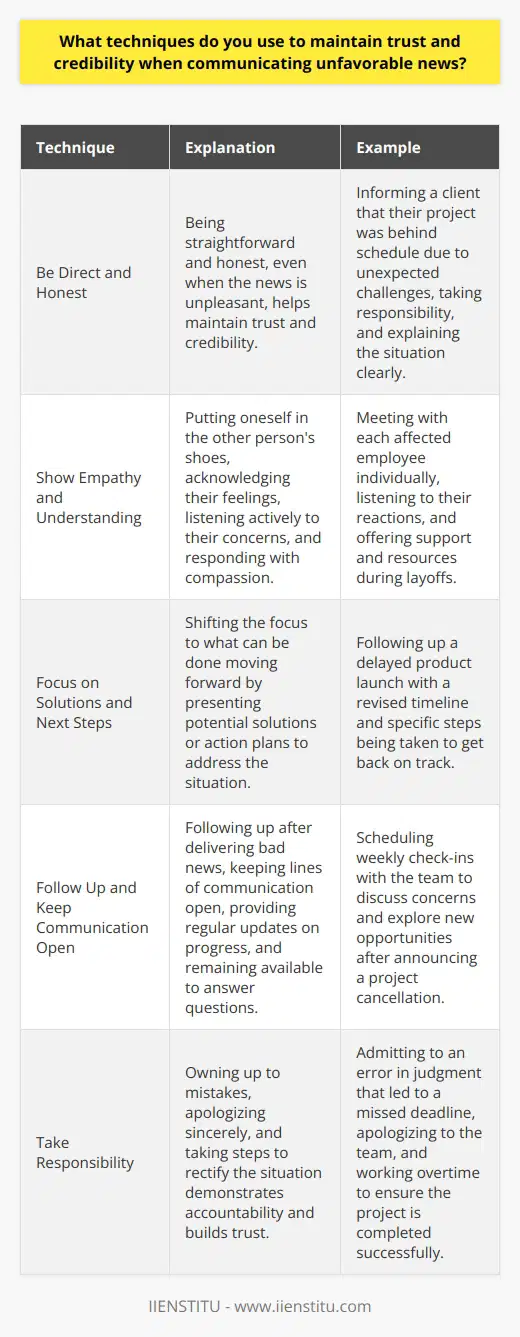
How do you handle a situation where you have limited information while communicating bad news?
When faced with the challenge of communicating bad news with limited information, I rely on a few key strategies. First, I gather as much accurate information as possible from reliable sources. This helps me provide a clear and honest assessment of the situation.
Empathy and Understanding
Next, I approach the conversation with empathy and understanding. I acknowledge the difficulty of the news and the impact it may have on the person or people involved. By showing genuine concern and care, I can help create a supportive environment for the discussion.
Clear and Concise Communication
When delivering the news, I aim to be clear and concise. I focus on the most important points and avoid speculation or unnecessary details. This helps ensure that the message is understood and reduces the risk of confusion or misinterpretation.
Offering Support and Solutions
After delivering the news, I offer my support and any available solutions or next steps. I listen actively to any concerns or questions and provide reassurance where possible. If I don't have all the answers, I commit to following up with more information as soon as I can.
Personal Example
I once had to inform a client that their project would be delayed due to unexpected supply chain issues. With limited details from our suppliers, I focused on what we did know and the steps we were taking to resolve the issue. By being transparent, empathetic, and solution-oriented, I was able to maintain trust and work with the client to adjust their timeline.
Continuous Improvement
Finally, I believe in learning from each experience. I reflect on what worked well and what I could improve for future situations. Communicating bad news is never easy, but with practice and a caring approach, it's a skill that can be developed over time.
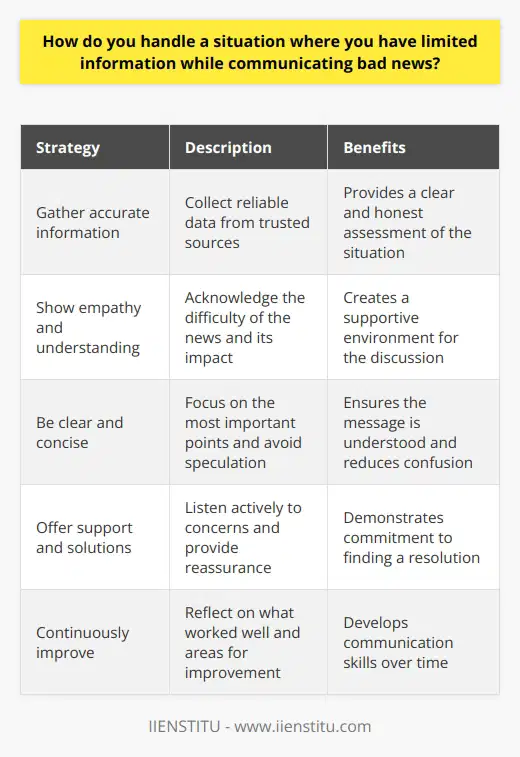
What are some potential pitfalls to avoid when communicating bad news?
When communicating bad news, it's crucial to be direct and honest while maintaining empathy and professionalism. One potential pitfall is beating around the bush or sugarcoating the message, which can lead to confusion and mistrust.
Be Clear and Concise
I once had to inform a client that their project was going to be delayed by several weeks. Instead of providing a vague explanation, I clearly outlined the reasons behind the delay and the steps we were taking to get back on track. By being transparent and direct, I maintained the client's trust and understanding.
Avoid Placing Blame
Another pitfall is placing blame or making excuses when delivering bad news. It's important to take responsibility and focus on solutions rather than pointing fingers. I've learned that phrases like "I take full responsibility" and "Here's what we're doing to resolve this" can go a long way in preserving relationships and demonstrating accountability.
Show Empathy and Respect
When sharing difficult information, it's essential to put yourself in the other person's shoes and acknowledge their feelings. I remember having to inform an employee that their position was being eliminated due to budget cuts. It was a tough conversation, but by actively listening to their concerns and offering support, I helped them feel valued and respected despite the unfortunate circumstances.
Follow Up and Provide Updates
After delivering bad news, don't leave the other person hanging. Make sure to follow up and provide regular updates on the situation. This shows that you're committed to finding a resolution and keeps lines of communication open.
In summary, when communicating bad news, be direct, empathetic, and solution-oriented. By avoiding these common pitfalls, you can navigate difficult conversations with professionalism and care.
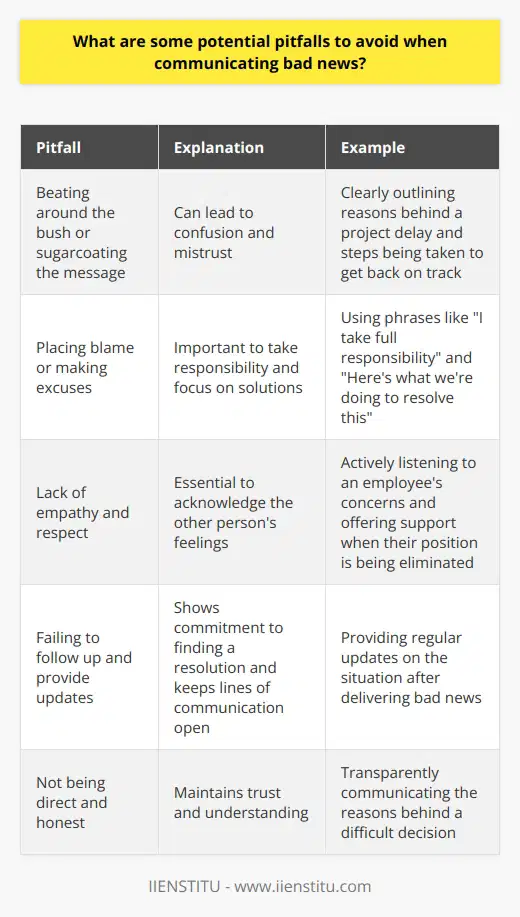
How do you ensure that the recipient feels supported after receiving unfavorable news?
When delivering unfavorable news, I prioritize the recipient's well-being and strive to provide genuine support. I believe clear, honest communication is key to maintaining trust and respect.
Empathize and Validate Feelings
I start by acknowledging that the news may be difficult to hear. I empathize with their perspective and validate any disappointment, frustration, or other emotions they express. Letting them know their feelings are understood helps build rapport.
Offer Concrete Next Steps
After delivering the message, I suggest actionable next steps they can take. Having a constructive path forward gives them a sense of control and shows that I'm invested in helping them move ahead despite the setback.
Provide Resources and Support
I follow up by offering relevant resources, contacts, or other forms of assistance that could be valuable as they navigate the situation. I make it clear I'm available if they have questions or need guidance.
Check In and Listen
In the days and weeks after sharing the news, I check in to see how they're doing. I ask open-ended questions and listen closely to understand their state of mind. Knowing that I care about their well-being, even after the initial conversation, provides ongoing reassurance.
Throughout the process, I'm guided by empathy, honesty and a commitment to their success. By combining caring candor with concrete support, I aim to help them feel heard and empowered to tackle challenges head-on.
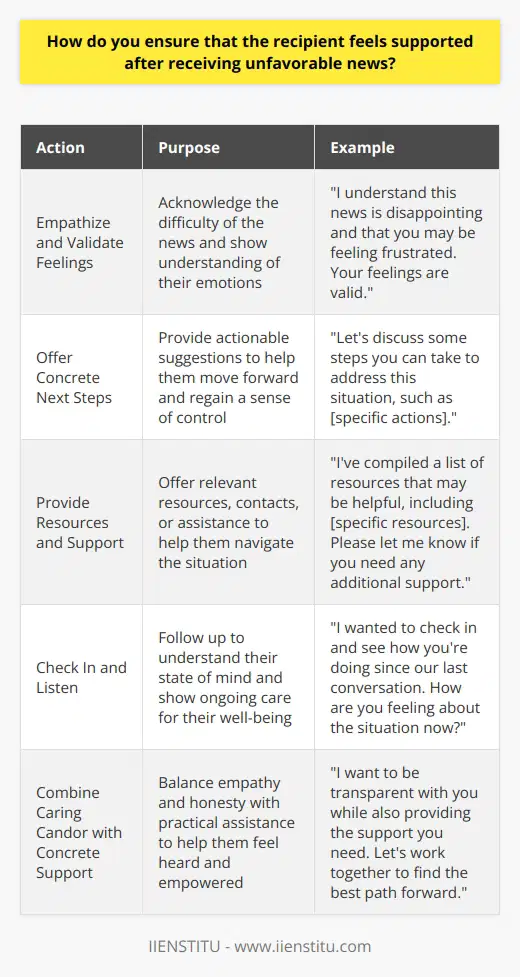
Can you discuss the importance of timing when communicating bad news?
When communicating bad news, timing is crucial. You want to deliver the message as soon as possible, but not hastily. It's important to find the right moment and setting to have a constructive conversation.
Consider the Recipient's Schedule and Mindset
Before breaking bad news, consider the other person's current situation. Are they in the middle of a stressful project or dealing with personal issues? If possible, wait for a time when they can focus on the conversation without added distractions or pressures.
I once had to tell a coworker that our project was being put on hold. I knew she had a big presentation coming up, so I waited until after it was over to share the news. By being mindful of her schedule, I showed respect and empathy.
Choose an Appropriate Setting
When possible, deliver bad news in person and in private. This allows for a more personal and supportive conversation. It also gives the recipient a safe space to process their emotions and ask questions.
I remember having to lay off an employee due to budget cuts. I made sure to have the conversation in my office with the door closed. This provided privacy and showed that I valued the sensitive nature of the discussion.
Be Prompt, But Not Abrupt
While you don't want to procrastinate, you also don't want to blindside someone with bad news. Strike a balance by being prompt but not abrupt. Give a brief heads-up that you need to discuss something important, then schedule a time to talk in detail.
In my experience, a simple message like "I have some updates about the project timeline. Can we meet this afternoon?" can help prepare the recipient without causing undue stress or speculation.

What lessons have you learned from past experiences communicating bad news?
Throughout my career, I've had to communicate bad news on several occasions. One key lesson I've learned is the importance of being direct and honest while still showing empathy and understanding for the person receiving the news.
Be Clear and Concise
When delivering bad news, it's crucial to be clear and concise. Beating around the bush or sugarcoating the message only prolongs the inevitable and can make the situation more uncomfortable for everyone involved. I've found that it's best to get straight to the point while still maintaining a respectful and professional tone.
Example:
In my previous role, I had to inform a client that their project was going to be delayed due to unforeseen circumstances. I scheduled a meeting with them, explained the situation clearly, and outlined the steps we were taking to get the project back on track. By being transparent and direct, we were able to maintain a positive relationship with the client despite the setback.
Show Empathy and Offer Support
Another important lesson I've learned is to show empathy and offer support when communicating bad news. It's essential to acknowledge the impact the news may have on the person and to let them know that you're there to help in any way you can.
Example:
When I had to lay off a team member due to budget cuts, I made sure to have a private conversation with them to explain the situation and express my genuine regret for having to let them go. I offered to provide a reference and assistance in their job search, which helped to soften the blow and maintain a positive relationship.
In summary, communicating bad news is never easy, but by being direct, honest, and empathetic, it's possible to handle these situations with professionalism and respect.
